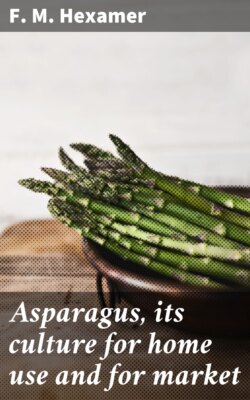Читать книгу Asparagus, its culture for home use and for market - F. M. Hexamer - Страница 9
ORNAMENTAL SPECIES
ОглавлениеA. medeoloides (Myrsiphyllum asparagoides), popularly known as Smilax.—For many years this has been, and is yet, one of the most commonly grown and the most serviceable of the plants used by florists as "green." It is readily grown from seed in the greenhouse. While a few other species of asparagus have been close rivals, it is yet unexcelled for many purposes of floral decorations.
A. plumosus (the plumy asparagus).—A very graceful climbing plant which for finer decoration has largely taken the place of smilax, its foliage being finer than that of the most delicate ferns, and will last for weeks after being cut. The whole plant is of a bright, cheerful green. Its branches spread horizontally, and branch again in such a manner as to form a flat, frond-like arrangement, the leaves being very numerous, in clusters of about a dozen, bright green, and one-half inch long. A native of South Africa, where it climbs over bushes and branches in moist situations. There are several named varieties of this, most of which have originated in gardens. The most distinct are A. tenuissimus and A. plumosus nanus, the fern-like appearance of which is seen in Fig. 2.
A. Sprengeri.—This is one of the best and most attractive house plants of recent introduction. It is of graceful form and habit when grown as a pot plant, but it is equally well suited for planting in hanging baskets. Its fronds are frequently four feet long, of a rich shade of green, and very useful for cutting, retaining their freshness for weeks after being cut. As a house plant it has exceeded expectations, as it stands dry atmosphere better than the older kinds of ornamental asparagus, and is not particular as to any special position. It delights in a well-enriched soil, rather light in composition, with plenty of drainage, and grows very rapidly. It is decidedly pretty when in bloom, its little flowers being pure white on short racemes, and the anthers are of a bright orange color. Fig. 3 gives a good idea of its graceful habit.
FIG. 3—ASPARAGUS SPRENGERI
A. falcatus.—One of the most striking twining plants for a large, temperate house. At the Kew Gardens, in London, England, is an enormous specimen of this species which is trained against the northern staircase, where it has formed a perfect thicket two yards through and twenty-five feet high, of long, rope-like, intertwining, spinous, fawn-colored stems, some of them fully fifty feet long, and clothed with wiry, woody branches, bearing whorls of leaves from two to three inches long and nearly one-fourth of an inch wide, falcate and bright green. The young stems are thick and succulent and gray-green, mottled with brown. For large conservatories, and particularly in moist, shady corners, where ordinary climbers will not thrive, this is an ideal plant. It is a native of the tropics of Asia and Africa, as well as the Cape.
A. laricinus (Fig. 4).—This handsome species has been in the Kew collection at least twenty years. It is grown in the succulent house, where, from a vigorous root system, it sends up annual stout succulent shoots, which grow to a length of about twelve feet, and when fully developed are decidedly ornamental. The stems are perennial, terete, dark brown, woody, one-half inch in diameter at the base, very spinous, freely branched, and branches zigzag and gray, the leaves in clusters one-fourth inch apart, hair-like, one and one-half inches long, bright green, persistent. Flowers axillary, many in a cluster, small, campanulate, white. Berries globose, dull red, one seeded, one-sixth of an inch in diameter. Common in various parts of South Africa. It is an excellent pillar plant.
FIG. 4—ASPARAGUS LARICINUS
A. racemosus.—This species is spread throughout the tropics of Africa and Asia; the Cape form of it is represented at Kew under the name of variety tetragonus, as shown in Fig. 5. This is a vigorous grower, with woody stems nine feet long, prickly at the base, fawn colored, freely branching above, each branch having at its base a sharp spine three-quarters of an inch long. The leaves are of a gray-green hue, four-angled, one-quarter of an inch long. Flowers in racemes two inches long, whitish, very fragrant. Berry red, globose, pulpy, one-seeded. An excellent climber for rafters, pillars, etc., growing vigorously under ordinary treatment. Its root system is a dense mass of tubers.
A. sarmentosus (Fig. 6).—An elegant evergreen species from South Africa, where it grows freely in moist situations, forming dense, brushy stems with short prickles, and studded with white, starry, fragrant flowers, which are followed with bright scarlet, pea-like berries; has stems four feet high, freely branched and clothed with dark green flat leaves three inches long. It is also grown in pots and baskets for the Cape-house, and when in flower it is greatly admired.
FIG. 5—ASPARAGUS RACEMOSUS, VAR. TETRAGONUS
FIG. 6—ASPARAGUS SARMENTOSUS
A. Broussoneti.—A beautiful hardy perennial climber from the Canary Islands, growing ten feet high; feathery foliage and scarlet berries. In the autumn this is very ornamental.
Among the most noteworthy of other ornamental species are: A. Aethiopicus, Africanus, Asiaticus, Cooperi, crispus, declinatus, decumbens, lucidus, retrofractus, scandens, tenuifolius, trichophyllus, umbellatus, verticillatus, virgatus, etc., etc.
